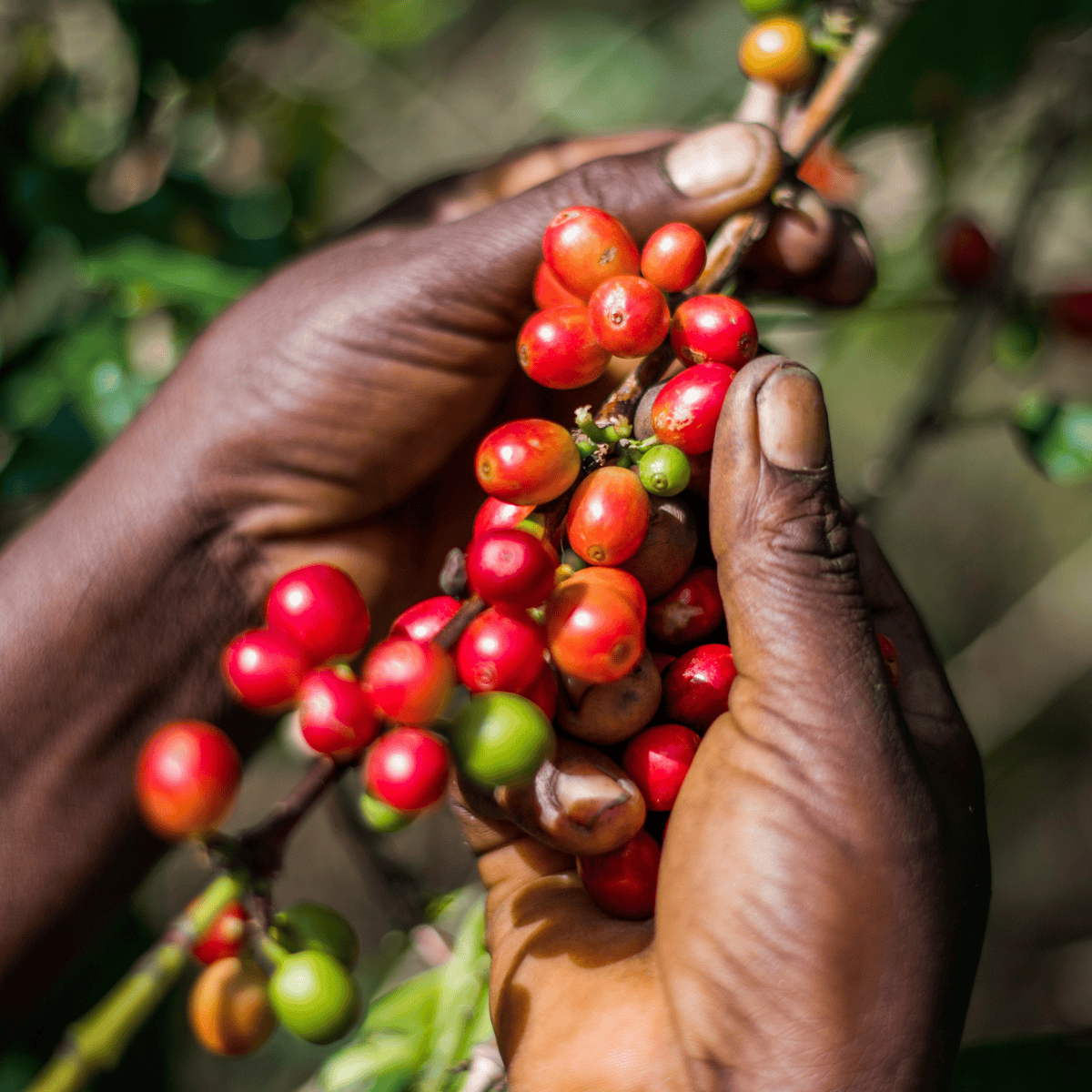Customer Portal

Where Arabica Coffee is Grown
by Jack Foster December 20, 2024 7 min read
Arabica beans make up a staggering 70% of the world coffee bean market. Yes - 70%! Although Arabica beans are so widely popular, not everyone knows exactly where they come from. To learn more about the history of Arabica coffee and where it’s grown, continue reading.
Arabica Coffee Origins and History
Arabica coffee, scientifically known as Coffea Arabica, is one of the most prized coffee species, dating back to 1000 BC. Its origins lie in the highlands of Ethiopia, where it was first discovered growing naturally in the Kaffa region.
According to legend, coffee was initially consumed as an energising food when an Ethiopian goat herder noticed his goats becoming unusually energetic after eating red berries from a particular plant. This discovery eventually led to the early use of coffee as a beverage.
From Ethiopia, Arabica coffee spread to Yemen, where it was cultivated and developed into a significant crop during the 7th century. Yemen became the centre of the early coffee trade, and the port city of Mokha emerged as a hub for exporting coffee beans to the Middle East and beyond.
The Dutch VOC obtained coffee plants from Yemen and established coffee plantations in Java, making it one of the first regions outside Arabia and Ethiopia to cultivate coffee on a large scale.
Java's success in coffee cultivation led to the spread of Arabica production to other Indonesian islands, including Sumatra and Sulawesi. The coffee grown in these regions became highly sought after, with Java coffee becoming synonymous with high-quality beans in European markets.
While Indonesia didn’t initiate the production of Arabica coffee, its role in popularising and expanding its cultivation globally is rather significant. By the 17th century, Arabica coffee reached Europe, where it quickly gained popularity.
Its journey continued as European colonial powers transported coffee plants to tropical regions in Asia, Africa, and the Americas - establishing it as a globally cultivated crop.
Fast forward to today, and Arabica remains the most widely consumed coffee variety, appreciated for its smooth, complex flavours and rich history.
Where is Arabica Coffee Grown?
So, where is Arabica coffee grown? Arabica coffee is grown in regions with specific climatic and geographic conditions that support its cultivation, such as countries like Brazil and Colombia.
These areas typically fall within the coffee belt - an imaginary belt wrapping around the best locations in the world for growing coffee. Arabica thrives in high-altitude regions with cooler temperatures, rich soil, and consistent rainfall.
The ideal altitudes sit between 600 and 2000 meters above sea level (depending on the latitude) and require temperatures between 15°C and 24°C (59°F and 75°F). These growing conditions ensure the development of the complex flavours and bright acidity that Arabica is known for.
Arabica still grows in its birthplace in Ethiopia and other African countries like Kenya, Rwanda, Uganda, Tanzania, and Burundi. These countries are known for beans with bright acidity and fruity or floral notes.
Currently, the largest producers of Arabica coffee are in Central and South America, with countries like Brazil, Colombia, and Costa Rica leading the way. Brazil is the top producer globally, offering a wide range of flavour profiles:
- Brazil - well-known for its unique flavour profile
- Colombia - renowned for its smooth, balanced coffee
- Costa Rica - known for its high-quality beans with vibrant acidity
In Asia, Indonesia, India, and Papua New Guinea are key players in Arabica production. Indonesia’s highlands produce unique coffee varieties, including Sumatra and Sulawesi, known for their earthy and spicy flavours.
India grows Arabica in the southern states of Karnataka, Kerala, and Tamil Nadu. Additionally, one of the few places in the United States where coffee is commercially grown is The Kona region of Hawaii, where the coffee is renowned for its smooth and mild flavour profile.

Growing Conditions for Arabica Coffee
Arabica coffee is highly sensitive to its growing environment, with specific conditions required to produce the highest quality beans. Each aspect of the environment, such as temperature, light, and humidity, plays a key role in the growth and flavour of Arabica coffee.
Temperature
Arabica coffee thrives in temperatures between 15°C and 24°C (59°F and 75°F). These moderate conditions allow the coffee plants to grow at a steady pace, which is vital for the gradual development of complex flavours in the beans.
If the temperature is too high, it can stress the plants, leading to lower-quality beans and reduced yields. Conversely, temperatures that drop too low can harm the plants, causing frost damage or slowing their growth significantly. This is why Arabica is typically grown in high-altitude regions where cooler temperatures prevail.
Light
Arabica coffee plants require ample sunlight for photosynthesis, but they also benefit from partial shade, especially in regions with intense sun exposure. The interplay of light and shade helps maintain ideal temperatures around the plant and reduces water evaporation from the soil.
Shade-grown coffee not only protects plants from excessive heat but also contributes to more sustainable farming practices by preserving biodiversity and preventing soil erosion. Proper light management ensures the plants remain healthy and productive, directly affecting the quality of the coffee beans.
Humidity
Humidity is another key factor, as Arabica coffee plants require consistent moisture to thrive. Ideal growing conditions include moderate to high humidity levels, typically found in subtropical or tropical climates with regular rainfall.
Adequate humidity keeps the soil hydrated and supports the development of the plant’s fruit. However, overly wet conditions can lead to fungal diseases, such as coffee leaf rust, while excessively dry conditions can stunt growth or reduce bean quality.
Proper water drainage and well-timed rainfall are essential for balancing humidity levels in Arabica-growing regions. By maintaining these optimal growing conditions (moderate temperature, balanced light exposure, and sufficient humidity), farmers can ensure the production of high-quality Arabica coffee beans.
Characteristics of the Arabica Coffee Plant
Coffee Arabica is celebrated not only for its distinct flavour but also for the unique traits of its plants, leaves, and flowers. These characteristics contribute to its high quality and global popularity.
Arabica coffee is renowned for its complex and distinct flavour profile, often described as:
- Sweet
- Smooth
- Well-balanced
Its taste can include notes of fruit, sugar, chocolate, nuts, or floral elements, depending on the region where it’s grown and the processing methods used. Arabica also has higher acidity compared to other coffee types, which contributes to its bright and lively taste.
This refined flavour profile is why Arabica is the preferred choice for specialty coffee. Arabica coffee plants are relatively small and compact, growing to a height of about 2.5 to 4.5 meters (8 to 15 feet) when left unpruned.
In cultivated settings, farmers often keep the plants shorter to facilitate easier harvesting and maintenance. The plant has a delicate structure, which makes it less hardy compared to its counterpart, Robusta.
Arabica plants have oval-shaped leaves that are dark green and glossy. The leaves are slightly larger than those of Robusta and serve as an indicator of the plant’s health. The flowers of the Arabica plant are small, white, and highly fragrant, resembling jasmine in appearance and scent.
These flowers bloom in clusters, and their delicate nature reflects the sensitivity of the plant to environmental conditions. The flowering period is relatively short, and successful pollination is critical for the development of coffee cherries.
These characteristics - its flavour, plant structure, and aesthetic features, highlight why Arabica coffee is prized by growers and consumers alike. Its delicate nature and specific cultivation needs make it a labour-intensive crop but one that produces some of the finest coffee in the world.
Arabica vs. Robusta Coffee
The key differences between Arabica and Robusta coffee are flavour profile, caffeine content, growing conditions and the overall perceived quality.
Arabica
- Preferred for its complexity and known for its sweet, smooth, and nuanced flavours, with notes of fruit, sugar, chocolate, or floral elements.
- It has higher acidity, giving it a bright and complex taste, and contains lower caffeine levels (0.8–1.5%).
- Arabica grows at higher altitudes (600–2000 meters) in cooler climates, requiring more specific conditions.
- It is more delicate and less resistant to pests and diseases, and produces lower yields per plant, requiring more labour-intensive cultivation, making it more expensive.
Robusta
- Offers a stronger, harsher taste with earthy, nutty, or woody notes. Often has a bitter aftertaste and a more straightforward flavour.
- Has nearly double the caffeine content of arabica (1.7–2.7%), contributing to its bold and intense flavour.
- Unlike Arabica coffee, Robusta thrives at lower altitudes (200–800 meters) in hotter climates.
- It is more robust and resistant to pests, drought, and diseases.
- Has higher yields and is easier to cultivate, resulting in lower production costs.
Arabica currently dominates the global market, accounting for about 60–70% of coffee production. It is valued for high-quality coffee offering a more refined experience. Robusta therefore makes up about 30–40% of global coffee production, and is commonly used in instant coffee and espresso blends.
Arabica Coffee Varieties
Let’s take a look at some of the most popular Arabica coffee varieties:
- Typica - the original variety of Arabica coffee, from which many other types have evolved. It is known for its excellent cup quality, with a smooth and balanced flavour. However, it has low yields and is less resistant to pests and diseases.
- Bourbon - a natural mutation of Typica, named after the island of Bourbon (now Réunion). It produces slightly higher yields and is prized for its sweet, complex flavors with notes of caramel and fruit.
- Caturra - a natural mutation of Bourbon that originated in Brazil. It is a dwarf variety, making it easier to cultivate and harvest, and offers good yields with a bright, clean flavor profile.
- Catimor - a hybrid of Caturra and a disease-resistant variety, Timor Hybrid. It is valued for its resistance to coffee leaf rust and high productivity, though its flavor is sometimes considered less refined than traditional Arabica varieties.
- Jackson - a Bourbon derivative commonly grown in East Africa, particularly Rwanda. It is known for its resistance to disease and produces beans with bright acidity and fruity notes.
- Kona - a unique variety grown on the volcanic slopes of Hawaii’s Big Island. It offers a smooth, mild flavor with notes of fruit and nuts, often with a buttery finish, and is highly sought after due to its exclusivity.
- Pacamara - a hybrid of Pacas (a Bourbon mutation) and Maragogipe (a Typica mutation). It is recognized for its large beans and distinctive flavor, which often includes floral, citrus, and chocolate notes.
- Villalobos - a rare Arabica variety known for its adaptability to harsh growing conditions and steep slopes. It offers high cup quality with bright acidity and complex flavours, making it a favourite for speciality coffee.
Each of these Arabica types contributes unique characteristics to the cup, influenced by their genetic heritage and growing conditions.
Leave a comment
Comments will be approved before showing up.
Also in Updates
Hey there! Fancy 10% Off?
Sign up to our newsletter and we'll send you all our latest offers, including 10% off your first coffee order!















